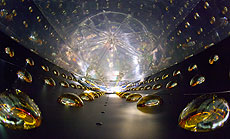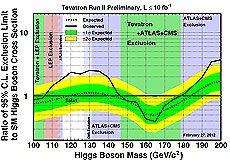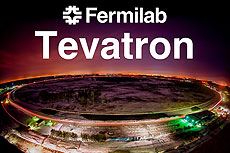|
Have a safe day!
Thursday, March 8
2:30 p.m.
Theoretical Physics Seminar - Curia II
Speaker: Alex Kagan, University of Cincinnati
Title: Direct CP Violation in D Decays
3:30 p.m.
DIRECTOR'S COFFEE BREAK - 2nd Flr X-Over
THERE WILL BE NO ACCELERATOR PHYSICS AND TECHNOLOGY SEMINAR TODAY
Friday, March 9
3 p.m.
DIRECTOR'S COFFEE BREAK - 2nd Flr X-Over
3:30 p.m.
Joint Experiment-Theoretical Physics Seminar -
One West
Speakers: Fabrizio Margaroli, University of Rome, and Christian Schwanenberger, University of Manchester
Title: New Results from CDF and D0 for the Winter 2012 Conferences
Click here for NALCAL,
a weekly calendar with links to additional information.
Upcoming conferences |
|
Thursday, March 8
- Breakfast: Apple sticks
- Tomato florentine
- BBQ pork sandwich
- Smart cuisine: Kielbasa & sauerkraut
- Smart cuisine: Chicken marsala
- Smoked turkey melt
- Assorted sliced pizza
- Southwestern chicken salad w/ roasted corn salsa
Wilson Hall Cafe Menu
|
|
Friday, March 9
Dinner
- Mushroom duxelle
- Sea bass w/ braised leeks and mustard sauce
- Thai rice pilaf
- Steamed asparagus
- Tiramisu
Wednesday, March 14
Lunch
- Cornish game ens w/ mushroom sauce
- Wild rice
- Caramelized carrots
- Pina colada cheesecake
Chez Leon Menu
Call x3524 to make your reservation. |
|
Daya Bay: Discovery of a new kind of neutrino transformation
 |
|
The internal view of one of Daya Bay's antineutrino detectors. Photo: Roy Kaltschmidt, Lawrence Berkeley National Laboratory
|
The Daya Bay Reactor Neutrino Experiment, a multinational collaboration operating in the south of China, today reported the first results of its search for the last, most elusive piece of a long-standing puzzle: how is it that neutrinos can appear to vanish as they travel? The surprising answer opens a gateway to a new understanding of fundamental physics and may eventually solve the riddle of why there is far more ordinary matter than antimatter in the universe today.
Traveling at close to the speed of light, the three basic neutrino "flavors" - electron, muon, and tau neutrinos, as well as their corresponding antineutrinos - mix together and oscillate (transform), but this activity is extremely difficult to detect. From Dec. 24, 2011, until Feb. 17, 2012, scientists in the Daya Bay collaboration observed tens of thousands of interactions of electron antineutrinos, caught by six massive detectors buried in the mountains adjacent to the powerful nuclear reactors of the China Guangdong Nuclear Power Group. These reactors, at Daya Bay and nearby Ling Ao, produce millions of quadrillions of elusive electron antineutrinos every second.
Read more
|
In memoriam: James C. Humbert
Former Fermilab employee James C. Humbert, 76, died on Tuesday, March 6. He worked at the laboratory from 1967 to 1995 in TD, as an engineering associate.
Visitation will take place from 4 to 7 p.m. today at the Healy Chapel. The memorial service will take place at 10:30 a.m. on Friday, March 9, also at the Healy Chapel.
Please click here to read Humbert's full obituary. For more information, please call 630.897.9291.
|
Physicists in China nail a key neutrino measurement
From Science, March 8, 2012
Elusive particles called neutrinos are the chameleons of the subatomic world. They come in three different types or "flavors" that can morph into one another as they zip along at near-light speed barely interacting with anything else. Now, physicists working at a nuclear power plant in China have made the last measurement needed to describe those "neutrino oscillations." The result completes a conceptual picture of neutrinos and paves the way for experiments that would search for an asymmetry between the behavior of neutrinos and antineutrinos and could help explain why the universe contains so much matter and so little antimatter.
"It's not just a parameter, it's a gateway," says Robert Plunkett, a physicist at Fermi National Accelerator Laboratory in Batavia, Illinois, who works on an accelerator-based neutrino experiment called MINOS.
Read more
|
Boost for Higgs from Tevatron data
From Nature, March 7, 2012
Final analysis suggests the US collider saw signs of the elusive particle.
A hint of the Higgs boson, the missing piece in the standard model of particle physics, has been found in data collected by the Tevatron, the now-shuttered US particle collider at Fermilab in Batavia, Illinois.
While not statistically significant, the indications announced on 7 March at the Moriond conference in La Thuile, Italy, are consistent with 2011 reports of a possible standard model Higgs particle with a mass of around 125 GeV from experiments at the Large Hadron Collider at CERN near Geneva, Switzerland.
Researchers on the Tevatron see an excess of events produced in the machine's proton–antiproton collisions that could be caused by a Higgs with a mass between 117 and 131 GeV.
Read more
|
|
Exciting hints of Higgs boson in the Tevatron data
 |
| If the entire Tevatron Run II program was repeated a hundred times and the Higgs boson did not exist, then the observed limit at each mass point would fall within the green band 68 times and within the yellow band 95 times.
|
The decades long hunt for the Higgs boson might be soon over. The first results using the Tevatron's full data set show tantalizing hints of what the future might bring. The Higgs boson is the only fundamental particle predicted by the Standard Model that has not been observed.
Finding the Higgs boson would validate a key aspect of the Standard Model - the use of the Higgs mechanism to generate the masses of the weak force carriers. The Higgs field would also explain why quarks and charged leptons have mass. A sensitive search that rules out the existence of the Higgs boson would indicate that new physics must exist to explain particle masses and may herald the start of an exciting era of discovery. Either result from the search for the Higgs boson, observation or exclusion, will mark a turning point in the road for the field of high energy physics.
The Standard Model does not predict the mass of the Higgs boson, but does dictate its behavior for a given mass. While the Higgs boson favors decaying into a pair of b quarks below a mass of 135 GeV/c2 and a pair of W bosons above that mass, CDF and DZero scientists exploit all possible decay modes in their search. Each search channel is optimized to discriminate its type of Higgs boson candidate events from its particular combination of backgrounds.
Read more
—Mike Cooke and Ben Kilminster
 |
| The CDF and DZero collaborations thank AD, PPD and CD for the important
fundamental contributions they have made to our physics program and we
acknowledge support from many national and international funding
agencies, especially the U.S. DOE and the NSF.
|
|
|